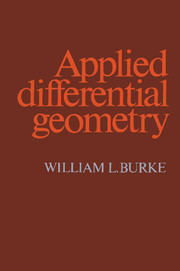Book contents
- Frontmatter
- Contents
- Preface
- Glossary of notation
- Introduction
- I Tensors in linear spaces
- II Manifolds
- III Transformations
- IV The calculus of differential forms
- V Applications of the exterior calculus
- VI Classical electrodynamics
- VII Dynamics of particles and fields
- VIII Calculus on fiber bundles
- IX Gravitation
- Bibliography
- Index
VII - Dynamics of particles and fields
Published online by Cambridge University Press: 05 June 2012
- Frontmatter
- Contents
- Preface
- Glossary of notation
- Introduction
- I Tensors in linear spaces
- II Manifolds
- III Transformations
- IV The calculus of differential forms
- V Applications of the exterior calculus
- VI Classical electrodynamics
- VII Dynamics of particles and fields
- VIII Calculus on fiber bundles
- IX Gravitation
- Bibliography
- Index
Summary
Classical mechanics displays the advantages of differential forms as well as electrodynamics does. The development of mechanics that I give here is slightly unusual, in that it takes place in the special contact bundles called jet bundles rather than in the tangent and cotangent bundles. Only for time-independent systems are the tangent and cotangent bundles the proper ones. Contact bundles are not usually mentioned, perhaps because they lack natural coordinates. This lack forces us to use generators for the contact ideal that appear to single out the t direction. Once the lack of symmetry in the generators is understood, however, the contact bundle CM is seen to be much simpler than the tangent bundle TM The geometric structure of both TM and CM consists in the fact that there are special curves in the bundles, and these, when projected down to the base space, have tangent vectors that are truly tangent or contact elements truly in contact. In CM such curves are characterized as integral submanifolds of the contact ideal. TM has no such simple characterization. In fact, the structure of TM is best described by adding one more dimension and making it into a contact bundle.
Of course, analytical dynamics has been able to deal with timedependent Hamiltonians, but only by adding a spurious extra dimension, going to the cotangent bundle of spacetime. This extra dimension is in the way, and fouls up the geometry of kinetic theory, for example.
- Type
- Chapter
- Information
- Applied Differential Geometry , pp. 305 - 346Publisher: Cambridge University PressPrint publication year: 1985

